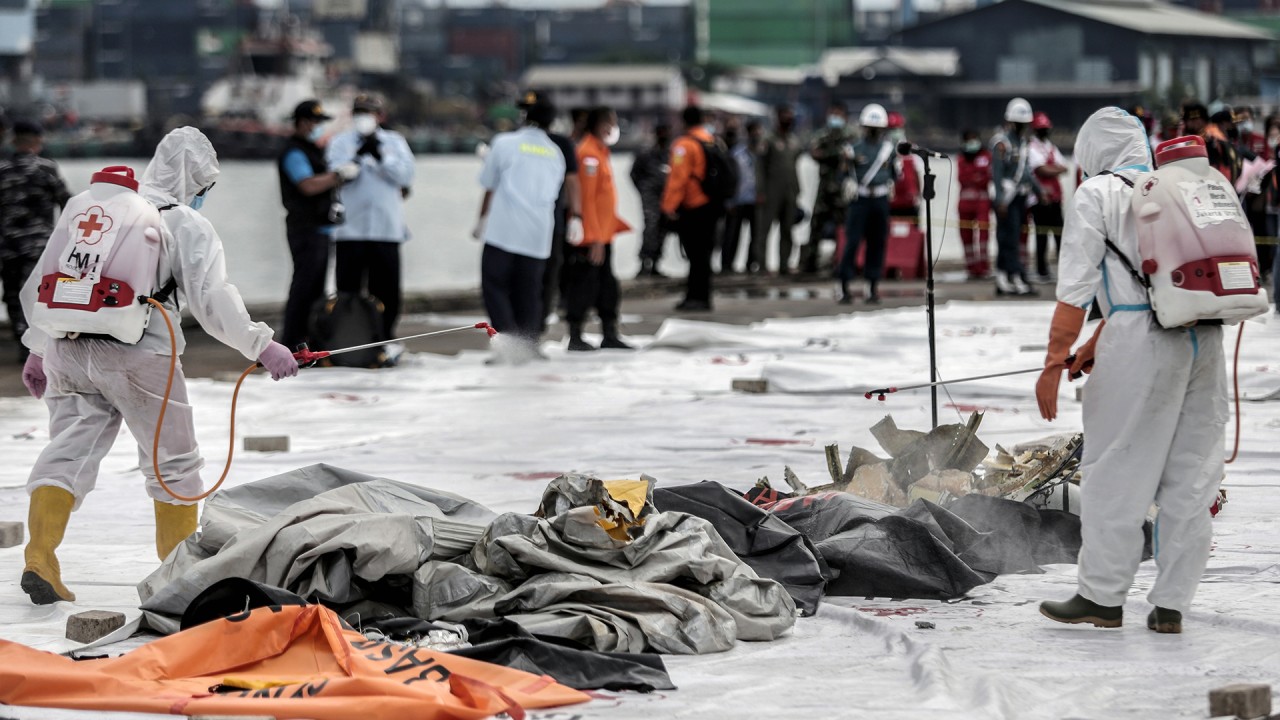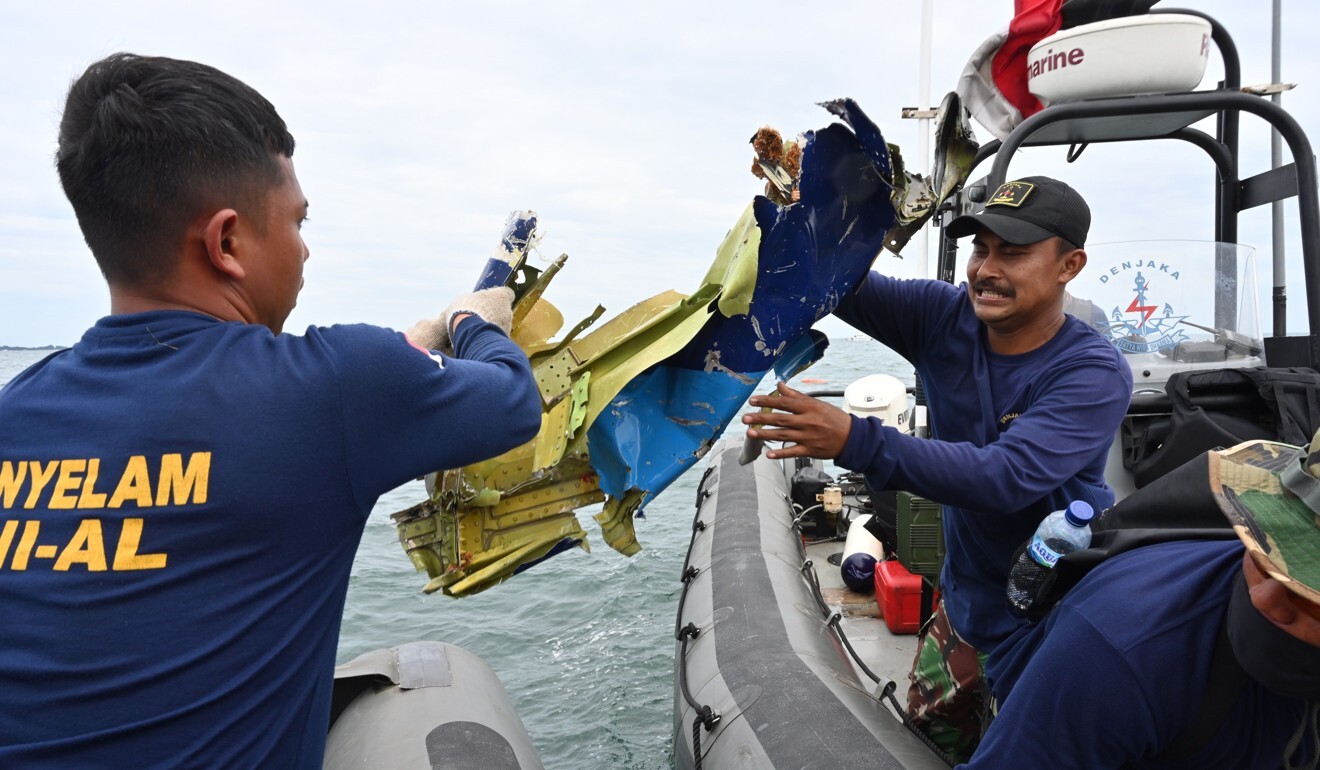
Explainer | Sriwijaya Air flight SJ 182: why is Indonesia the deadliest place in Asia for plane crashes?
- The loss of Sriwijaya Air flight SJ 182 is the latest in a string of tragedies to have hit Indonesian aviation, which has suffered 2,353 deaths since 1945
- Historically, mountainous terrain, a large population and bad weather have played a part. For SJ 182, was pilot rustiness due to Covid-19 also a factor?
Fifty passengers and 12 airline employees, all Indonesians, are believed to have died on board the Boeing 737-500 when it crashed into the Java Sea on Saturday at 2.40pm local time, just four minutes after taking off from Jakarta.
‘We surrender to the Almighty’: families mourn as divers pluck wreckage from sea
The cause of the crash is as yet unknown. The pilots of the plane, bound for the city of Pontianak in West Kalimantan, were said to be experienced and the airline, which largely plies domestic routes, had a relatively good safety record with no fatal accidents since it was set up in 2003.

01:31
Indonesian divers film wreckage of crashed Sriwijaya Air passenger jet on seabed
HOW BAD IS INDONESIA’S AVIATION SAFETY RECORD?
Previous disasters have been attributed to factors including regulatory oversight, inadequate aircraft maintenance and communication failures.
Indonesia finds wreckage in search for Sriwijaya Air plane
However, other factors have played a part. One is the sheer number of flights in a country made up of thousands of islands and 270 million people. International air passenger traffic in the country tripled between 2005 and 2017, according to the Centre for Aviation, while in 2019 Indonesia was the 15th largest domestic market in 2019 when it recorded 91.3 million passengers, according to the International Civil Aviation Organization.
Other factors include the country’s mountainous terrain and frequent bad weather, especially during the tropical monsoon season. Heavy rain delayed SJ 182’s take-off for half an hour.
From 2007 to 2018, all Indonesian airlines were banned from flying into the European Union. The US implemented a similar ban between 2007 and 2016, citing inadequate technical expertise and weak safety standards.

02:13
Indonesian families wait for clues as search for crashed Boeing 737 continues in Java Sea
INDONESIA’S DEADLIEST PLANE CRASHES: A TIMELINE
2018: A Lion Air Boeing 737 MAX plunges into the Java Sea soon after take-off from Jakarta’s Soekarno-Hatta International Airport, killing 189 passengers and crew;
2015: An Indonesian military plane crashes into a residential area in Medan in June, killing more than 140 people – 122 on board and at least 20 on the ground;
2014: An Airbus A320 from AirAsia, en route from Surabaya to Singapore, crashes into the Java Sea in 2014, killing all 162 people on board;
2007: On New Year’s Day, an Adam Air Boeing 737-400 plunges into the sea off Sulawesi Island, after taking off from Surabaya for Manado, killing 102 passengers and crew;
2005: A Mandala Airlines plane heading towards Jakarta comes down in a residential area in Medan, killing at least 150 people including passengers, crew and people on the ground;
1997: Indonesia suffers its worst aviation crash when a Garuda Indonesia Airbus A300 crashes in Medan, killing all 234 people on board; in the same year, a Silk Air flight en route from Jakarta to Singapore crashes into a river near the Indonesian city of Palembang, killing 104 people in an alleged pilot murder-suicide;
1991: An Air Force plane crashes soon after take-off in East Jakarta, exploding and ploughing into a building. It kills 135 people, including 121 airmen, 12 crew and two people on the ground. One passenger survives.

COULD THE LATEST CRASH HAVE BEEN CAUSED BY RUSTY PILOTS DUE TO THE LACK OF FLYING HOURS?
Investigators say it is too soon to tell what caused the Sriwijaya Air crash. According to the plane tracking website Flightradar24 the plane lost more than 10,000 feet in altitude within a minute.
Last September, Indonesia’s transport safety regulator highlighted pilot proficiency and flying experience as a concern in its investigation into a Lion Air Airbus SE A330 that veered off the runway after landing. It was found that the pilot had flown less than three hours in the previous 90 days, while its first officer had not flown since the previous February.
Indonesia searches for missing Sriwijaya Air Boeing plane
“While flying rates have reduced across Asia and the world during Covid-19, and as a result of associated border closures, pilots would still be maintaining their core skills as part of mandatory recurrent simulator training at prescribed intervals. This would make them ‘current and legal to fly’,” said Dane Williams, director of Aviation Safety Asia, a Hong-Kong based consulting firm.
“However, factors such as confidence and reaction time may have been reduced if the crew involved had experienced reduced flying rates or a hiatus between flights, compared to their usual routine,” added Williams, who has conducted numerous aviation safety audits on Indonesian operators. Patrik Frykberg, an independent aircraft accident investigator, cautioned against starting technical investigations with a pre-conceived idea.
“The wisest action is to start gathering all the factual evidence in the shortest period of time. This means collecting the information regarding the records of the crew, the aircraft, maintenance records, aircraft performance, any weather information, the voice and flight data recorders, and any witness accounts,” said Frykberg.
“It is too early to establish if the human factor was a major contributing factor to this accident, as the CVR and the training records of the crew should be analysed carefully,” he added.
The sole objective of investigating incidents, Frykberg said, should be to prevent future occurrences, instead of apportioning blame or liability.

WILL THINGS IMPROVE AND WHAT HAPPENS NEXT?
Williams of Aviation Safety Asia said Indonesia needed to tighten safety standards.
“Ideally, the solution is for the Indonesian government to lead from the top and better train and resource the aviation regulator. [This includes] ensuring minimum standards and tight controls exist in relation to the issuance of air operators’ certificates, which allows operators to carry passengers on scheduled services,” said Williams.
On Monday, Indonesia was continuing its search for bodies. On Sunday, plane debris, body parts and clothing were all retrieved.
The police have since received 40 DNA samples and other medical records from relatives of victims to assist in identification.
Indonesia’s National Transportation Safety Committee said on Monday it was still hoping to retrieve the plane’s flight data recorder and voice cockpit recorder, known as the black boxes, which would provide information on the possible causes of the crash and final minutes of the flight. It also said the US National Transportation Safety Board and Boeing would be involved in the investigation.



